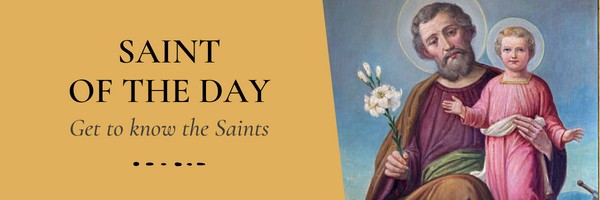 Dear readers, Catholic Online was de-platformed by Shopify for our pro-life beliefs. They shut down our Catholic Online, Catholic Online School, Prayer Candles, and Catholic Online Learning Resources essential faith tools serving over 1.4 million students and millions of families worldwide. Our founders, now in their 70's, just gave their entire life savings to protect this mission. But fewer than 2% of readers donate. If everyone gave just $5, the cost of a coffee, we could rebuild stronger and keep Catholic education free for all. Stand with us in faith. Thank you. Help Now >
Dear readers, Catholic Online was de-platformed by Shopify for our pro-life beliefs. They shut down our Catholic Online, Catholic Online School, Prayer Candles, and Catholic Online Learning Resources essential faith tools serving over 1.4 million students and millions of families worldwide. Our founders, now in their 70's, just gave their entire life savings to protect this mission. But fewer than 2% of readers donate. If everyone gave just $5, the cost of a coffee, we could rebuild stronger and keep Catholic education free for all. Stand with us in faith. Thank you. Help Now >
Ivory
FREE Catholic Classes
Ivory (French ivoire ; Italian avorio ; Latin ebur ), dentine, the tusks of the elephant, hippopotamus, walrus, and other animals: a tough and elastic substance, of a creamy white, taking a high and lasting polish, largely employed in the arts since pre-historic times, and used extensively in making or adorning ecclesiastical objects by the primitive and medieval Christians. In the museums of Europe there are examples of pre-historic incised and carved ivories, and also many specimens of Egyptian, Assyrian, Greek, and Roman bas-reliefs, statues, diptychs, plaques, and caskets. The classical authors frequently allude to ivory, and the Old Testament terms with references to its employment, even using its attributes as poetic qualifications, in the same way as the church does today in the Litany of Loretto ("Tower of ivory"). As soon as the Christians were free to display the symbols of their faith and illustrate its history pictorially, they adopted the art then in vogue for this purpose, and among their first æsthetic expressions, carved ivory diptychs were the most important; they followed closely the designs used in consular diptychs, excepting that symbolism and poetic imagery took the place of representations of mythological subjects. They consisted of two plates of ivory, hinged so as to fold together like a book; the inside of each leaf was slightly counter- sunk, with a narrow raised margin, so as to hold the wax that received the writing, while the outside of the leaves was profusely adorned with carvings. They were used for various purposes, such as listing the names of the baptized, bishops, martyrs, saints, and benefactors, and of the living and the dead who were to be prayed for.
That these diptychs suggested ivory plaques for book covers, reliquary doors and triptych shrines, is obvious; hundreds of plaques are in existence, dating from the time of Constantine to the sixteenth century, and many of them are exquisite works of art; in the British Museum there is one, six inches by four, divided into thirty panels, less than an inch square, and each compartment contains a scene from the life of the Blessed virgin, all being beautiful examples of ivory sculpture. Another use the early Christians found for ivory was the making of cylindrical pyxes from a cross section of the elephant tusk; upon the covers, they carved figures of Our Lord, St. Peter, and St. Paul, and on the side the Apostles and biblical subjects. Again, somewhat later, no doubt remembering that Solomon made "a great throne of ivory" ( 1 Kings 10:18 ), they overlaid their episcopal chairs with carved ivory tablets, as may be seen at Ravenna in the chair of St. Maximian, archbishop of that city (546). After the fifth century, possibly before, ivory crosiers were in use; eighty or more of them are now in existence, including those said to have belonged to a number of the saints. At the same time liturgical combs of ivory were in use. A beautiful example, the comb of St. Lupus (623), is in the treasury of St-Etienne at Lens. Representations of the Crucifixion in ivory upon various objects, are common, but not the crucifix. Most of the crucifixes date from the seventeenth century, and of these there are many, but of the earlier ones, only five have survived the action of time and the fanaticism of the Reformers. During the whole of the Middle Ages ivory was extensively used for paxes (instrumenta pacis), tabernacles, portable altars, caskets, holy-water buckets, statuettes, rosary-beads, seals, and the decoration of ecclesiastical furniture.
Join the Movement
When you sign up below, you don't just join an email list - you're joining an entire movement for Free world class Catholic education.
- Easter / Lent
- Ascension Day
- 7 Morning Prayers
- Mysteries of the Rosary
- Litany of the Bl. Virgin Mary
- Popular Saints
- Popular Prayers
- Female Saints
- Saint Feast Days by Month
- Stations of the Cross
- St. Francis of Assisi
- St. Michael the Archangel
- The Apostles' Creed
- Unfailing Prayer to St. Anthony
- Pray the Rosary
![]()
Copyright 2025 Catholic Online. All materials contained on this site, whether written, audible or visual are the exclusive property of Catholic Online and are protected under U.S. and International copyright laws, © Copyright 2025 Catholic Online. Any unauthorized use, without prior written consent of Catholic Online is strictly forbidden and prohibited.
Catholic Online is a Project of Your Catholic Voice Foundation, a Not-for-Profit Corporation. Your Catholic Voice Foundation has been granted a recognition of tax exemption under Section 501(c)(3) of the Internal Revenue Code. Federal Tax Identification Number: 81-0596847. Your gift is tax-deductible as allowed by law.







